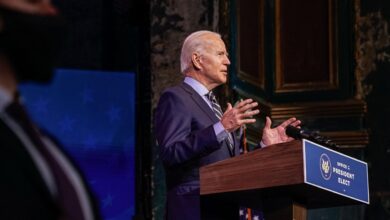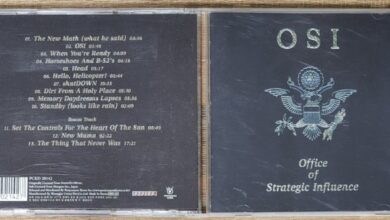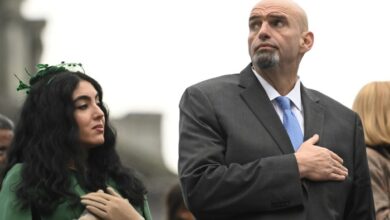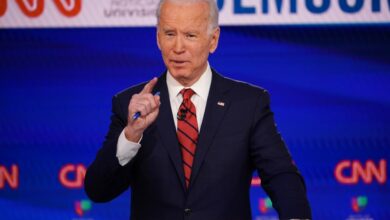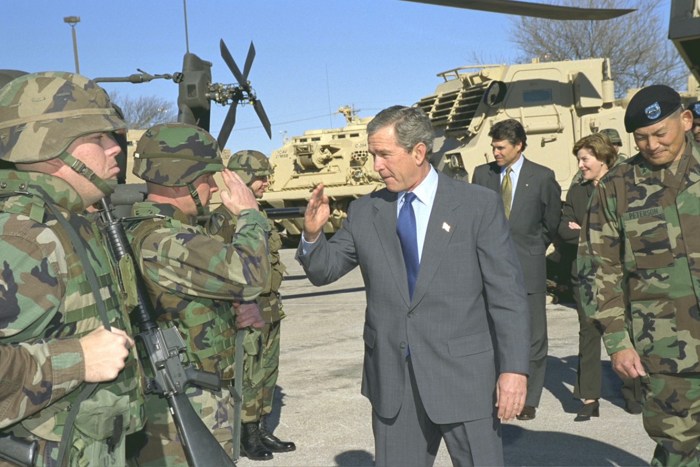
Bush Team Enlists Madison Avenue in War on Terror
Bush Team Enlists Madison Avenue in War on Terror: It sounds like a plot from a political thriller, but it’s a chilling reality. The aftermath of 9/11 saw the Bush administration, in their fight against terrorism, turn to the masters of persuasion: Madison Avenue.
This move sparked a debate that continues to resonate today. Was this a strategic necessity, or a dangerous blurring of lines between political messaging and advertising?
The administration, in their quest to rally public support, used Madison Avenue’s expertise to craft a narrative that would resonate with the American public. This involved creating a distinct brand for the “War on Terror” – a brand that would inspire patriotism, fear, and ultimately, support for military action.
But was this the right approach? Was it ethical to use advertising techniques to promote a political agenda?
The Bush Administration’s War on Terror

The “War on Terror,” a phrase that became synonymous with the George W. Bush administration’s response to the 9/11 attacks, was a multifaceted campaign that encompassed military action, domestic security measures, and a global effort to combat terrorism. This war was not simply a military conflict; it was a comprehensive strategy that sought to reshape the world in the wake of the attacks.
The Origins and Context of the War on Terror
The War on Terror was born out of the horrific events of September 11, 2001, when al-Qaeda, a terrorist organization led by Osama bin Laden, carried out a series of coordinated attacks on the United States. The attacks, which resulted in the deaths of nearly 3,000 people, shocked the nation and galvanized public opinion.
In response, President Bush declared a “War on Terror” and vowed to bring the perpetrators to justice.The War on Terror was not simply a reaction to the 9/11 attacks; it was also shaped by the broader context of the post-Cold War world.
The collapse of the Soviet Union had left the United States as the sole superpower, but it also created new security challenges. The rise of Islamic extremism, fueled by factors such as the Soviet invasion of Afghanistan and the US support for Israel, had created a potent threat to global security.
The 9/11 attacks, therefore, were not an isolated event but a culmination of these broader trends.
The Bush Administration’s Rationale for Using Madison Avenue Tactics
The Bush administration recognized the importance of public opinion in shaping the success of the War on Terror. They understood that winning the war would require not only military victory but also a sustained public commitment to the cause. To this end, they employed Madison Avenue tactics, drawing on the expertise of advertising and public relations professionals, to frame the conflict in a way that resonated with the American public.The administration’s rationale for using these tactics was based on the belief that the War on Terror was not just a military campaign but also a battle for hearts and minds.
The Bush administration’s “war on terror” wasn’t just about military might, it was about shaping public opinion. They enlisted Madison Avenue to craft a narrative that would rally the nation behind their cause. This wasn’t just about selling a product, it was about selling an idea, a way of thinking, and that involved pushing the media right, as detailed in this insightful article pushing the media right.
This media manipulation, coupled with the administration’s strategic use of fear, ultimately helped to build support for the Iraq War, a decision that continues to be debated today.
They aimed to create a narrative that demonized the enemy, portrayed the United States as a victim, and justified the use of military force. By tapping into the emotions of fear, anger, and patriotism, the administration sought to mobilize public support for the war effort.
Examples of How the Administration Framed the Conflict
The Bush administration employed a variety of tactics to frame the War on Terror in a way that appealed to the American public. Some key examples include:
- Using powerful imagery:The administration used iconic images, such as the burning Twin Towers, to evoke a sense of shock and outrage. These images were widely disseminated through the media and became powerful symbols of the attacks and the subsequent war effort.
The Bush administration’s “war on terror” wasn’t just a military campaign; it was a carefully crafted public relations strategy. They enlisted Madison Avenue to help shape public opinion, using the power of advertising and marketing to build support for their policies.
This strategy highlighted the intricate relationship between political power and the media, and it raises important questions about the role of mainstream media and propaganda in shaping public perception. Ultimately, the Bush administration’s use of Madison Avenue demonstrated how the war on terror was as much a battle for hearts and minds as it was a military conflict.
- Creating a narrative of good versus evil:The administration framed the conflict as a battle between freedom and tyranny, democracy and dictatorship. This narrative cast the United States as the defender of freedom and the enemy as a force of evil. The use of terms like “axis of evil” and “war on terror” reinforced this narrative.
The Bush administration’s “war on terror” wasn’t just about military might, it was about shaping public opinion. They enlisted Madison Avenue to craft a narrative that resonated with the American public, but it also revealed a deeper truth: the US contributes directly to armed conflicts around the world.
This involvement often fuels the very conflicts they aim to combat, creating a cycle of violence that’s hard to break. The Madison Avenue spin may have helped the Bush team win hearts and minds, but it couldn’t mask the complexities of the global stage.
- Appealing to patriotism and national unity:The administration emphasized the importance of national unity and called on Americans to come together in the face of a common threat. This message was used to garner support for the war effort and to counter any dissenting voices.
- Using fear and anxiety:The administration exploited the public’s fear of terrorism to justify the expansion of government powers and the implementation of security measures. This strategy was effective in mobilizing public support for the war but also contributed to the erosion of civil liberties.
The use of Madison Avenue tactics by the Bush administration in the War on Terror had a significant impact on public opinion and the course of the conflict. While these tactics were effective in mobilizing public support for the war effort, they also raised concerns about the manipulation of public sentiment and the erosion of democratic values.
The Role of Madison Avenue: Bush Team Enlists Madison Avenue In War On Terror
The “War on Terror” was not just a military campaign; it was also a public relations battle, and Madison Avenue played a pivotal role in shaping public opinion. The advertising industry, with its expertise in persuasion and messaging, was instrumental in building support for the war, both domestically and internationally.
Advertising Techniques and Branding
Madison Avenue agencies employed a range of advertising techniques to shape public opinion. One key strategy was branding. The “War on Terror” itself was a powerful brand, evoking images of strength, patriotism, and a fight against evil. The use of evocative imagery, such as the Twin Towers collapsing, was a powerful tool for creating emotional connections and a sense of urgency.
This branding strategy was further reinforced by the use of slogans like “Support Our Troops” and “Freedom is Not Free,” which resonated with the public’s emotions and values.
Messaging and Visual Imagery
The messaging used by Madison Avenue was carefully crafted to appeal to a wide range of audiences. The war was framed as a necessary response to a grave threat, emphasizing the dangers of terrorism and the need for decisive action.
The messages also stressed the importance of unity and patriotism, urging Americans to stand together in the face of adversity. Visual imagery played a crucial role in reinforcing these messages. The use of patriotic symbols, such as the American flag, and images of military personnel in action helped to create a sense of national pride and support for the war effort.
Historical Context
The Bush administration’s use of Madison Avenue in the War on Terror was not unprecedented. Throughout history, governments have employed propaganda techniques to influence public opinion and rally support for their policies. Understanding the historical context of this relationship helps shed light on the Bush administration’s approach and its impact on public perception.
Comparison with Other Propaganda Campaigns
The Bush administration’s use of advertising and public relations techniques in the War on Terror shares similarities with other historical propaganda campaigns. A notable example is the American government’s use of propaganda during World War II. The Office of War Information (OWI) created posters, radio broadcasts, and films to promote patriotism, encourage wartime sacrifices, and demonize the enemy.
Like the Bush administration, the OWI used emotionally charged language and imagery to appeal to the public’s fears and sense of national identity.
- Similarities:Both the Bush administration and the OWI used emotionally charged language and imagery to appeal to the public’s fears and sense of national identity.
- Differences:The Bush administration’s use of Madison Avenue was more sophisticated and targeted, relying on market research and consumer psychology to tailor messages to specific demographics.
The Development of the Relationship Between Advertising and Government
The relationship between advertising and government has evolved over time, from a more limited role in the early 20th century to a more prominent and strategic partnership in the latter half of the century. During World War I, the United States government began using advertising to promote war bonds and encourage public support for the war effort.
This marked the beginning of a growing trend of government agencies using advertising techniques to communicate with the public.
- Early 20th Century:Limited use of advertising by government agencies.
- Mid-20th Century:Increasing use of advertising for social and political purposes.
- Late 20th Century:Strategic partnerships between government and advertising agencies for public relations and communication campaigns.
Evolution of Public Opinion Towards the “War on Terror”
Public opinion towards the War on Terror has evolved over time, influenced by various factors, including the initial shock and anger following the 9/11 attacks, the ongoing conflict in Iraq and Afghanistan, and the increasing costs of the war in terms of human life and financial resources.
- Initial Support:The 9/11 attacks sparked widespread public support for the War on Terror, with high approval ratings for the Bush administration’s actions.
- Growing Skepticism:As the war in Iraq dragged on, public support for the conflict declined, and concerns about the war’s cost and effectiveness grew.
- Long-Term Impact:The War on Terror has had a lasting impact on American society, shaping public discourse, influencing foreign policy, and raising questions about the role of government in the lives of citizens.
Contemporary Relevance
The “War on Terror” remains a potent and enduring concept in contemporary society, impacting global politics, security measures, and social discourse. While its initial focus on the immediate aftermath of 9/11 has evolved, the underlying anxieties and strategies persist, shaping how we perceive and respond to threats, both real and perceived.
The Enduring Legacy of the “War on Terror”
The “War on Terror” continues to shape global security landscapes and political agendas. Its impact is evident in:
- Persistent Military Engagements:Ongoing military interventions in Afghanistan, Iraq, and other regions, often justified as part of the “War on Terror,” demonstrate its lasting influence on foreign policy.
- Enhanced Surveillance and Security Measures:The “War on Terror” has led to increased surveillance, security checks, and border control measures, raising concerns about civil liberties and privacy.
- The Rise of Counterterrorism Legislation:Countries have enacted counterterrorism laws that broaden government powers, sometimes at the expense of individual rights.
- The Global War on Drugs:The “War on Terror” has been intertwined with the “War on Drugs,” with both contributing to the militarization of law enforcement and the expansion of the prison system.
The Role of Media and Public Discourse
The media plays a significant role in shaping public perceptions of terrorism, often through:
- Sensationalized Reporting:Media outlets often prioritize dramatic stories and visuals, which can contribute to fear and prejudice.
- Framing and Narrative Control:The way terrorism is presented in the media can influence how audiences understand its causes, motivations, and consequences.
- The Amplification of Certain Voices:Media coverage can give disproportionate attention to specific individuals or groups, potentially amplifying their influence and shaping public opinion.
Ethical Implications of Advertising Techniques, Bush team enlists madison avenue in war on terror
The use of advertising techniques in the context of contemporary conflicts raises ethical concerns, including:
- Manipulation and Propaganda:The persuasive power of advertising can be used to manipulate public opinion and support for specific policies or actions.
- Dehumanization of the Enemy:Advertising techniques can be used to portray opponents as inhuman or subhuman, justifying violence and reducing empathy.
- The Commodification of Conflict:The use of advertising techniques can turn complex political issues into consumable products, potentially trivializing their importance.

